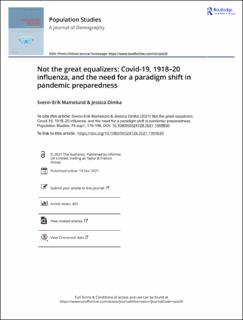| dc.contributor.author | Mamelund, Svenn-Erik | |
| dc.contributor.author | Dimka, Jessica | |
| dc.date.accessioned | 2022-02-11T12:15:56Z | |
| dc.date.available | 2022-02-11T12:15:56Z | |
| dc.date.created | 2021-05-28T09:27:00Z | |
| dc.date.issued | 2021-12-13 | |
| dc.identifier.citation | Population Studies. 2021, 75 (1), 179-199. | en_US |
| dc.identifier.issn | 0032-4728 | |
| dc.identifier.issn | 1477-4747 | |
| dc.identifier.uri | https://hdl.handle.net/11250/2978472 | |
| dc.description.abstract | Despite common perceptions to the contrary, pandemic diseases do not affect populations indiscriminately. In this paper, we review literature produced by demographers, historians, epidemiologists, and other researchers on disparities during the 1918–20 influenza pandemic and the Covid-19 pandemic. Evidence from these studies demonstrates that lower socio-economic status and minority/stigmatized race or ethnicity are associated with higher morbidity and mortality. However, such research often lacks theoretical frameworks or appropriate data to explain the mechanisms underlying these disparities fully. We suggest using a framework that considers proximal and distal factors contributing to differential exposure, susceptibility, and consequences as one way to move this research forward. Further, current pandemic preparedness plans emphasize medically defined risk groups and epidemiological approaches. Therefore, we conclude by arguing in favour of a transdisciplinary paradigm that recognizes socially defined risk groups, includes input from the social sciences and humanities and other diverse perspectives, and contributes to the reduction of health disparities before a pandemic hits. | en_US |
| dc.description.sponsorship | This paper was written from research funded by two Research Council of Norway grants: (1) CorRisk—Early Covid-19 wave in Norway: Social inequality in morbidity, compliance to non-pharmaceutical interventions and labour market consequences (grant number 312716); and (2) PANRISK—Socio-economic risk groups, vaccination and pandemic influenza (grant number 302336). | en_US |
| dc.language.iso | eng | en_US |
| dc.publisher | Routledge | en_US |
| dc.relation.ispartofseries | Population Studies;Volume 75, 2021 - Issue sup1: 75 years of Population Studies: A diamond anniversary special issue | |
| dc.relation.uri | https://www.tandfonline.com/doi/full/10.1080/00324728.2021.1959630 | |
| dc.rights | Navngivelse 4.0 Internasjonal | * |
| dc.rights.uri | http://creativecommons.org/licenses/by/4.0/deed.no | * |
| dc.subject | Covid-19 | en_US |
| dc.subject | 1918–20 ‘Spanish’ influenza pandemic | en_US |
| dc.subject | Socio-economic statuses | en_US |
| dc.subject | Ethnicities | en_US |
| dc.subject | Pandemic preparedness | en_US |
| dc.subject | Social health determinants | en_US |
| dc.title | Not the great equalizers: Covid-19, 1918–20 influenza, and the need for a paradigm shift in pandemic preparedness | en_US |
| dc.type | Peer reviewed | en_US |
| dc.type | Journal article | en_US |
| dc.description.version | publishedVersion | en_US |
| dc.rights.holder | © 2021 The Author(s). | en_US |
| cristin.ispublished | true | |
| cristin.fulltext | original | |
| cristin.qualitycode | 2 | |
| dc.identifier.doi | https://doi.org/10.1080/00324728.2021.1959630 | |
| dc.identifier.cristin | 1912422 | |
| dc.source.journal | Population Studies | en_US |
| dc.source.volume | 75 | en_US |
| dc.source.issue | 1 | en_US |
| dc.source.pagenumber | 179-199 | en_US |
| dc.relation.project | Norges forskningsråd: 312716 | en_US |
| dc.relation.project | Norges forskningsråd: 302336 | en_US |

